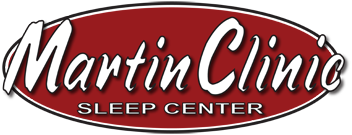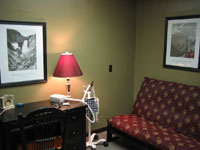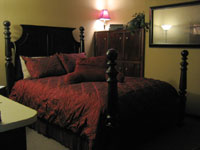Sleep testing can be an intimidating experience. Many patients who have undergone treatment recall their apprehension prior to their sleep study. Most of these patients would agree that the benefits of therapy far outweigh the inconvenience of evaluation.
Prior to undergoing a sleep study, all patients must be seen in consultation during a daytime office visit at Martin Clinic Sleep Center. The purpose of this consultation is to obtain medical history and a better understanding of each patient's complaints and symptoms. This discussion allows us to anticipate the best approach for effective evaluation during your sleep study.
What is a sleep study?
A sleep study at Martin Clinic Sleep Center is a painless test that examines your quality of sleep and provides necessary information for your physician to accurately diagnose and treat your sleep disorder. To complete the test, you will spend one night in a private bedroom suite at the sleep lab.
Your personal suite features such comforts as a premium bed, high quality bedding and standard TV. An educational video on sleep apnea will be shown. During the night, measurements are recorded and data is collected that identify sleep stages, as well as brain and body system functioning.
Sleep study requests may be initiated by you or your physician by calling Martin Clinic Sleep Center to schedule an appointment.
What should I expect during a sleep study?
We understand the distress our patients feel and we are committed to helping each patient find hope for an improved quality of life. A stay at our sleep lab is the first step in your journey back to restful sleep and healthier living.
We provide a home-like setting with cozy private rooms. Equipment is non-invasive and allows patients to sleep just as they would at home. Every detail of the process is designed to be comfortable and stress free. Many patients, in fact, report that they awaken feeling more rested than they have in a long time.
On the day of your sleep study, try to avoid caffeine after noon and try not to nap. Before arriving, wash and dry your hair, but do not apply any products. Pack an overnight bag as you would for an overnight hotel stay. You may wish to bring your own pillow and toiletries. If you have special needs, please advise us prior to your visit and, if possible, we will be happy to accommodate you.
During the night, measurements are recorded and data is collected that identify sleep stages, as well as brain and body system functioning. To measure brain waves, heart rate, airflow and eye movements, electrodes are placed on the head, chest, legs and under the chin. Bands are placed around the rib cage and abdomen to measure breathing movements, and a device is placed on your finger which measures blood oxygen levels.
All of these sensors are non-invasive and allow you to turn and move as you normally do while sleeping. Equipment and technicians remain in a separate room for your comfort and privacy. During the night, the sensors relay signals to a central control room where diagnostic equipment is located. After your night at the sleep center, board certified sleep specialists analyze the data collected. A detailed report is prepared that will help your physician diagnose and treat any identified sleep disorders.
Types of Sleep Studies
Diagnostic Polysomnography
Diagnostic Polysomnography (PSG) is performed to document physiological events occurring during sleep. The test consists of a continuous recording, generally lasting from 6-8 hours and occurring during a patient's typical sleep hours. The parameters that we monitor include limited electroencephalogram (EEG) (central & occipital), eye movement and muscle tone (EMG) for the purpose of staging sleep, respiratory effort by chest and abdominal movement, nasal and oral airflow, limb movements, limited electrocardiogram (ECG) and oxygen saturation by non-invasive pulse oximetry. The patient's sleep behavior is also monitored using infrared lighting and a closed circuit camera. Additional parameters are included if ordered.
Continuous Positive Airway Pressure Titration
Continuous Positive Airway Pressure (CPAP) Titration is performed while the patient is breathing on CPAP in an effort to eliminate respiratory events occurring during the patient's sleep. CPAP is initiated and is titrated upward until respiratory events, sleep arousals, and snoring are eliminated.
PSG With CPAP Therapy Trial
PSG with CPAP therapy trial (Split Night) is a combination test incorporating both a diagnostic PSG and a CPAP titration over the course of one night. The apnea/hypopnea index (AHI) must meet or exceed insurance carrier requirements during the diagnostic portion of the study; which may vary by insurance carrier. The parameters monitored include those recorded in the diagnostic PSG with the addition of CPAP levels during the therapy trial. CPAP therapy may be initiated at lower AHI levels upon the physician's request; however, in these cases caution must be taken to meet specific guidelines to justify CPAP rental coverage at home.
Multiple Sleep Latency
Multiple Sleep Latency (MSLT) is performed to provide objective documentation of daytime sleepiness and to definitively diagnose narcolepsy. This test is routinely performed following a diagnostic PSG to ensure there are no significant disruptions during the preceding night of sleep that contribute to sleepiness during the testing process. Urine drug screens are also performed to ensure sleepiness is not artificially induced. The testing includes limited EEG (central & occipital), eye movement, muscle tone for the purpose of staging sleep, and an ECG. The patient is recorded during 4 to 5 nap opportunities occurring every 2 hours lasting approximately 20-30 minutes following the PSG. Sleep behavior is also monitored using infrared lighting and a closed circuit camera.
Maintenance of Wakefulness Test (MWT)
Maintenance of Wakefulness Test is performed to document the patientís ability to maintain wakefulness during 4 to 5 twenty-minute periods evenly spaced throughout the day in which he/she is monitored while sitting in a dark, quiet room without stimulation. The parameters monitored are the same as those for the MSLT. This test is often used to measure treatment effectiveness.
For more information about sleep studies and a better understanding of sleep apnea, please visit these sites:
Respironics – What is Obstructive Sleep Apnea (OSA)?
National Heart, Lung and Blood Institute – What Is Sleep Apnea?
The following video presentation provides further insight into the diagnosis and management of sleep apnea.


